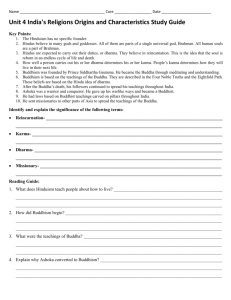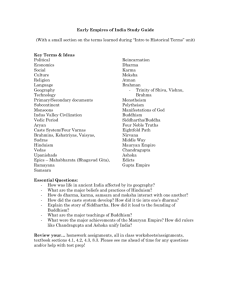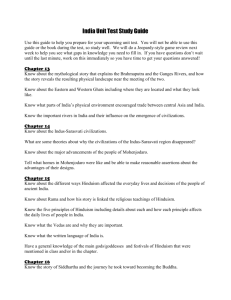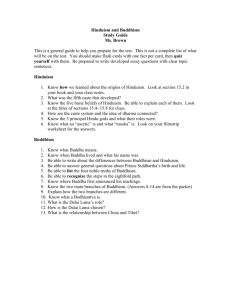Hinduism
advertisement
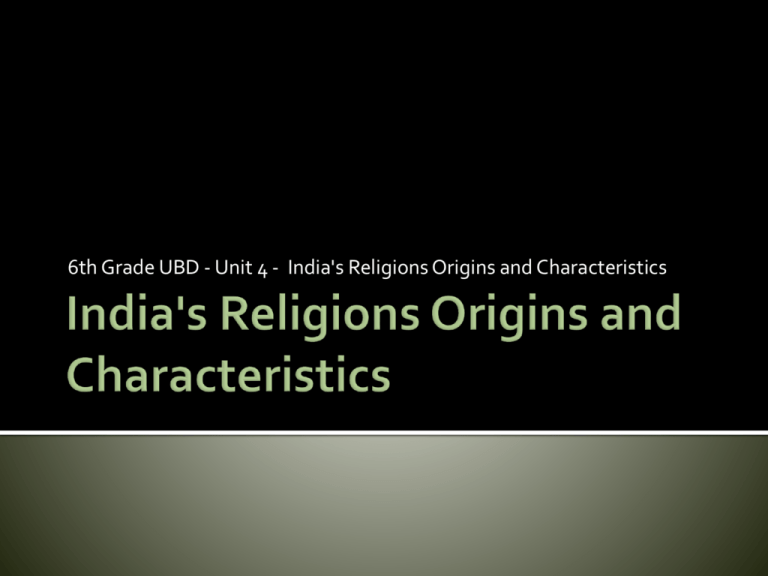
6th Grade UBD - Unit 4 - India's Religions Origins and Characteristics Hinduism- Hinduism arose among the Aryan invaders of India around 1500 BCE. Modern India is a land of many religions, but Hindu beliefs and practices are the most dominant. Buddhism- Buddhism arose out of Hinduism. It shares some of its beliefs and practices. Buddhism is a religion in which the idea of a god is not important. Ashoka’s Conversion- Ashoka was the third Mauryan emperor. He became a Buddhist and played a large role in spreading Buddhism throughout Asia. South Asia has a great deal of cultural diversity, or variety. Think about the idea of diversity. The United States is culturally diverse, too. Why do you think this is so? (5 minutes) Work with a neighbor and compare your answer with theirs. What things are the same and what things are different? (3 minutes) Hinduism has no specific founder. Hindus believe in many gods and goddesses. All of them are parts of a single universal god, Brahman. All human souls are a part of Brahman. Hindus are expected to carry out their duties, or dharma. They believe in reincarnation. This is the idea that the soul is reborn in an endless cycle of life and death. How well a person carries out his or her dharma determines his or her karma. People’s karma determines how they will live in their next life. Religion often has had an important effect on culture. It often has helped to define the levels and roles of the people in society. The effect of religion was especially powerful in ancient Indian society and culture. Video- The History of Hinduism The founders of most of the major religions are well known. The names of Moses, Jesus, and Muhammad are recognized around the globe. Unlike most of the world’s religions, Hinduism has no founder and no central organization. Historians believe that the beginning of Hinduism occurred around 1500 BCE. Around this time, the Aryan people conquered India. Certain beliefs of the early inhabitants of the region were absorbed into the religion of the Aryan people to create Hinduism. Hinduism teaches that everything in the universe is all part of one god. The gods and goddesses, people, animals, and all objects, are part of this oneness, or unity. Hindus believe that all life is connected and should be treated with respect. Video- The Practices of Hinduism Every culture has its own code of rules for people to live by. Often, these rules are created by leaders or a central government. Religious customs often influence the official laws of a society. Hinduism does not have a particular set of rules or teachings, but it still affects the way that people live their lives. Hindus believe that the universe is an endless cycle of life, death, and rebirth. Hindus also believe in reincarnation. According to this idea, when a person dies, he or she is reborn in a new physical form. The final goal of life is to achieve moksha, or the “union with Brahman.” Key Term ReincarnationThe belief that the soul is reborn after death in human –or some other form. How close one comes to moksha in a lifetime depends on the law of karma. Karma is a positive or negative force. It is a result of good or bad actions taken during a person’s lifetime. Hindus believe every action has a good or bad reaction. These actions and reactions affect a person’s life. They also determine how people will be reborn in future lives. Key Term Karma- Describes how a person’s actions in one life can influence and affect the next life. Hinduism also teaches that all human beings should act according to their dharma. Dharma is the religious and moral duties of a person. These duties are connected to a person’s role in society. Dharma also depends on a person’s caste, or social level. They also depend on a person’s age and sex. Dharma is different for men and women. Hinduism also places a value on human love and family life. It encourages a turning away from material things in old age. Dharma helps determine his or her role in society in the next life. Key Term Dharma- The religious law that describes the way people should live in order to maintain the natural order of the world. The cow is the most holy animal in the Hindu religion. Because of this, Hindus do not eat beef. In fact, many Hindus eat only vegetables, fruits, and grains. Buddhism was founded by Prince Siddhartha Gautama. He became the Buddha through meditating and understanding. Buddhism is based on the teachings of the Buddha. They are described in the Four Noble Truths and the Eightfold Path. These beliefs are based on the Hindu idea of dharma. After the Buddha’s death, his followers continued to spread his teachings throughout India. Video- The Middle Way of Compassion Buddhism originated in India. A legend tells the story of Prince Siddhartha Gautama. When leaving the palace one day, he saw an old man, a sick man, a dead body, and a poor monk. These sights disturbed him and he wondered how he could end so much suffering in the world? For six years, Prince Gautama wandered seeking an answer to human suffering. Finally, Gautama decided to meditate his way to truth and sat down under a tree. He relaxed his body. He emptied his mind of all thoughts. Gautama came to understand the cause of human suffering through meditation. He came to understand the way around it was inner peace. The prince had become the Buddha. The name “Buddha” means “awakened one,” or “the one who knows.” The Buddha’s message was a simple one. It presented a way of action for people to follow. This way of living begins with the Four Noble Truths. Four Noble Truths All life is full of suffering The cause of human suffering is desire The cure for suffering is ending desire The way to overcome desire is to follow the Eightfold Path The Eightfold Path provided a system for people to follow in their daily lives. Its teachings help people to live a life somewhere between a life without material goods and a life devoted to wealth and ease. By following the Eightfold Path and living a good and honest life, one could achieve nirvana. Nirvana is a state of heavenly peace and freedom from desire and suffering. Buddhism was spread throughout Asia by the Buddha’s missionary followers in the centuries following his death. Key Term MissionarySomeone sent on a religious or charitable mission to a foreign country; often to convert others to a particular religion. Ashoka was a warrior and conqueror. He gave up his warlike ways and became a Buddhist. He had laws based on Buddhist teachings carved on pillars throughout India. He sent missionaries to other parts of Asia to spread the teachings of the Buddha. Video- Ashoka Becomes a Buddhist Ashoka became emperor about 265 BCE, and he set out to extend his empire by force. He conquered the last of India’s independent kingdoms. Ashoka conquered other lands to the west and extended his kingdom to cover most of India. He established very harsh laws. A person could be put to death for even a small crime. An accomplished soldier, Ashoka extended the lands of the empire until he invaded the Kalingas around 256 BCE. Ashoka undertook a mission to defeat them and was successful. With many tens of thousands killed, the Kalinga War is thought to be one of the worst battles in the history of India. Overcome by the death and destruction he witnessed, Ashoka converted to Buddhism and instituted new policies throughout the empire. Ashoka promoted peace, opened universities, and established new trade routes for his people. He had stone pillars erected throughout India that told his story and shared his religious philosophies with his people. What has been the “muddiest” point so far in this lesson? That is, what topic remains the least clear to you? (4 minutes) Work with a neighbor and compare your muddiest point with theirs. Compare what things are the same and what things are different? (3 minutes)
